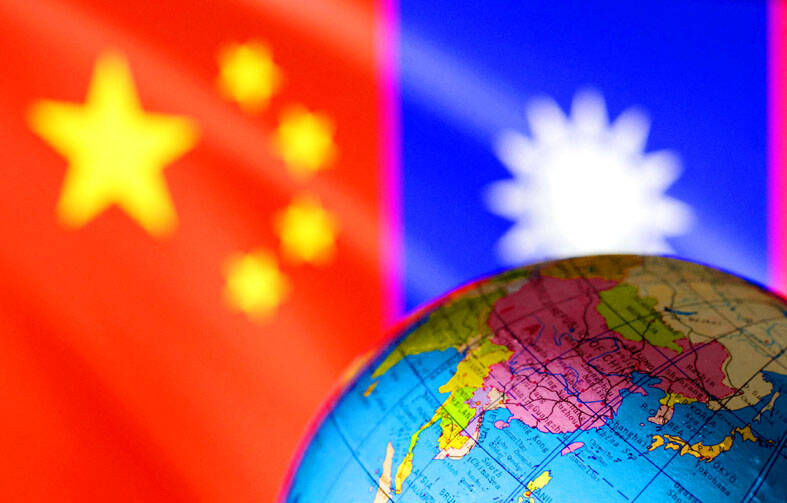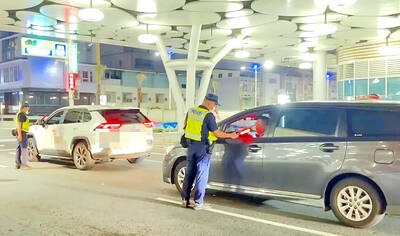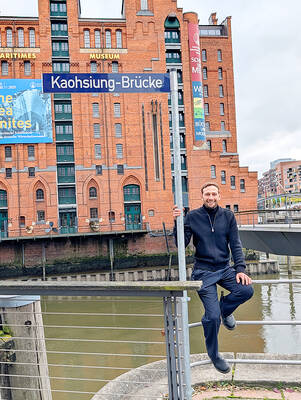President William Lai’s (賴清德) stopovers in Hawaii and Guam during his first overseas trip to Taiwan’s Pacific diplomatic allies are indicative of a Taiwan-US alliance to counter China’s Belt and Road Initiative (BRI), a Taipei-based security expert said on Sunday.
Lai arrived in Hawaii on Saturday for a two-day stopover on his trip to Palau, Marshall Islands and Tuvalu, and is scheduled to make a stopover in Guam on his return trip.
Lai’s trip is set to “link” the first, the second and third island chains, said Su Tzu-yun (蘇紫雲), a research fellow at the government-funded Institute for National Defense and Security Research.

Photo: Reuters
Taiwan is on the first island chain, while Guam and Palau are along the second island chain, and Hawaii is on the third island chain, Su said.
The three island chains are strategically important for curbing China’s expansionism and, in particular, the BRI, he said.
The first island chain is the “first line of defense” against Chinese expansionism and a critical maritime route for fuel, with Taiwan at the center of this chain, Su said.
As China is building deep-water harbors in the Solomon Islands and Peru and a space tracking station in Kiribati, fortifying the second island chain aids efforts to defend the first island chain is in the interest of the US and its allies, he said.
Meanwhile, open-source data showed that the George Washington Carrier Strike Group (CSG) is deployed in Yokosuka, Japan, while the Abraham Lincoln CSG is in Port Klang, Malaysia, and the USS Carl Vinson supercarrier is in the East Pacific.
Asked if such deployments were made to deter China from overreacting to Lai’s passing through the US state and territory, Association of Strategic Foresight research fellow Chieh Chung (揭仲) said they were aimed to deter China, but were unlikely related to Lai’s itinerary.
Academics have said that there is a high possibility Lai’s transit stops in the US could trigger Beijing, causing it to hold large-scale military exercises near Taiwan, in part to “set the ground rules” for US president-elect Donald Trump regarding Taiwan.
However, this is unlikely as such a tactic could irritate Trump and have the opposite effect, the academic added.
Rather, the move is likely intended to warn China not to engage in any unnecessary or provocative behavior in the Taiwan Strait in the run-up to Jan. 20, when Trump is to be inaugurated, he added.
The first island chain refers to the archipelago consisting of the Aleutian Islands, the Japanese archipelago, South Korea, the Ryukyu Islands, Taiwan, the Philippines and the Greater Sunda Islands.
The second island chain refers to the Izu Islands, the Bonin Islands, the Mariana Islands, the Caroline Islands, Guam, Palau and Halmahera Island.
The third island chain refers to Alaska, Hawaii, US- governed Pacific Islands, Australia and New Zealand.

TRAFFIC SAFETY RULES: A positive result in a drug test would result in a two-year license suspension for the driver and vehicle, and a fine of up to NT$180,000 The Ministry of Transportation and Communications is to authorize police to conduct roadside saliva tests by the end of the year to deter people from driving while under the influence of narcotics, it said yesterday. The ministry last month unveiled a draft of amended regulations governing traffic safety rules and penalties, which included provisions empowering police to conduct mandatory saliva tests on drivers. While currently rules authorize police to use oral fluid testing kits for signs of drug use, they do not establish penalties for noncompliance or operating procedures for officers to follow, the ministry said. The proposed changes to the regulations require

The Executive Yuan yesterday announced that registration for a one-time universal NT$10,000 cash handout to help people in Taiwan survive US tariffs and inflation would start on Nov. 5, with payouts available as early as Nov. 12. Who is eligible for the handout? Registered Taiwanese nationals are eligible, including those born in Taiwan before April 30 next year with a birth certificate. Non-registered nationals with residence permits, foreign permanent residents and foreign spouses of Taiwanese citizens with residence permits also qualify for the handouts. For people who meet the eligibility requirements, but passed away between yesterday and April 30 next year, surviving family members

Taiwanese officials are courting podcasters and influencers aligned with US President Donald Trump as they grow more worried the US leader could undermine Taiwanese interests in talks with China, people familiar with the matter said. Trump has said Taiwan would likely be on the agenda when he is expected to meet Chinese President Xi Jinping (習近平) next week in a bid to resolve persistent trade tensions. China has asked the White House to officially declare it “opposes” Taiwanese independence, Bloomberg reported last month, a concession that would mark a major diplomatic win for Beijing. President William Lai (賴清德) and his top officials

The German city of Hamburg on Oct. 14 named a bridge “Kaohsiung-Brucke” after the Taiwanese city of Kaohsiung. The footbridge, formerly known as F566, is to the east of the Speicherstadt, the world’s largest warehouse district, and connects the Dar-es-Salaam-Platz to the Brooktorpromenade near the Port of Hamburg on the Elbe River. Timo Fischer, a Free Democratic Party member of the Hamburg-Mitte District Assembly, in May last year proposed the name change with support from members of the Social Democratic Party and the Christian Democratic Union. Kaohsiung and Hamburg in 1999 inked a sister city agreement, but despite more than a quarter-century of